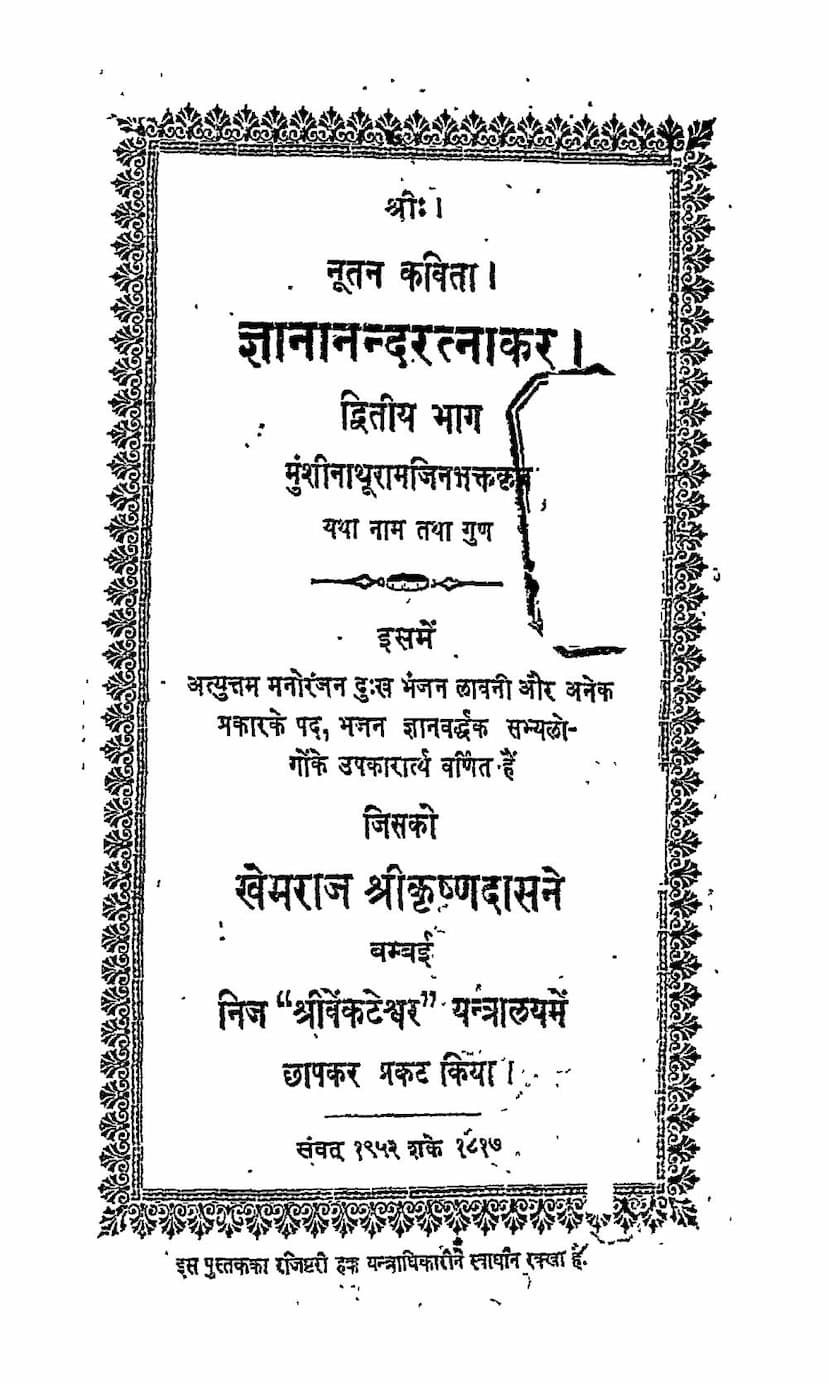Gyanand Ratnakar Part 02
Added to library: September 1, 2025

Summary
Here's a comprehensive summary of the Jain text "Gyananand Ratnakar Part 02" by Nathuram Munshi, based on the provided text:
Title: Gyananand Ratnakar, Part 02 (Meaning "Ocean of Joyful Knowledge") Author: Nathuram Munshi (referred to as "Munshi Nathuram Jinbhakta" - Nathuram, a devotee of Jin/Jain Tirthankaras) Publisher: Khemraj Krishnadas Publication Year: Samvat 1952 (Vikram era) / 1817 (Shaka era) Location: Published at "Shri Venkateshwar" Press, Mumbai. Copyright: Registered copyright held by the publisher.
Overview and Purpose:
"Gyananand Ratnakar Part 02" is a collection of devotional songs, poems, and teachings (often in the form of lavanis, dohas, savaiyas, kabitts, and prabhatis) primarily aimed at glorifying the Jain Tirthankaras and imparting spiritual knowledge to its readers. The book's title, "Gyananand Ratnakar," reflects its intention to provide both knowledge and bliss, acting as an "ocean of joyful knowledge." It is described as offering "excellent entertainment," "sorrow-dispelling," and various types of songs and verses that are beneficial and enlightening for cultured individuals.
Content and Structure:
The book is structured as a collection of various poetic forms, each dedicated to a specific Jain Tirthankara, Jain concept, or devotional theme. The Table of Contents (Anukramanika) lists over 90 distinct pieces, categorized by their form and subject matter. Key themes and types of content include:
-
Praise of Tirthankaras: A significant portion of the book is dedicated to praising the 24 Jain Tirthankaras. This includes:
- Specific lavanis (a type of song) dedicated to Rishabhdev, Parshvanath, and other Tirthankaras individually.
- Lavnis describing the distinguishing symbols (chihna) of the 24 Tirthankaras.
- Lavnis and other poetic forms related to the Panch Kalyanaks (five auspicious events) of Rishabhdev.
- Lavnis praising the 46 virtues of Arihants and their freedom from 18 types of defects.
- Lavnis describing the miracles (atishaya) of Jain temples.
- Lavnis detailing the continuing presence and teachings of the 20 Viharmān Tirthankaras (those in the Middle Continent).
- Kavitts and dohas dedicated to various Tirthankaras like Ajitnath, Sambhavnath, Abhinandanath, Sumatinath, Padmaprabhu, Suparshvanath, Chandraprabhu, Pushpadant, Shitalnath, Shreyanshnath, Vasupujya, Vimalnath, Anantnath, Dharmanath, Shantinath, Kunthunath, Arhanath, Mallinath, Munisuvratnath, Neminath, and Parshvanath.
- A vinati (prayer) to the 24 Tirthankaras.
-
Core Jain Teachings and Concepts:
- Panch Parmeshthi: Numerous pieces focus on the veneration of the Panch Parmeshthi (Arihant, Siddha, Acharya, Upadhyaya, Sadhu), particularly the Namokar Mantra (Panchanjali, Namokar ki Lavani). The text explains the meaning and significance of each line of the mantra.
- Guidance for Devotion: Several lavanis and pads emphasize the importance of devotion to Jinavara (Jain Tirthankaras) through "mind, speech, and body." They stress the futility of worldly attachments and the ephemeral nature of life, urging readers to focus on spiritual practice.
- Jain Philosophy: There are discussions on the cycle of birth and death (chaurasi lakh yoni), the importance of the human birth (nar bhav), and the path to liberation (moksha).
- Virtues and Conduct: Pieces like "Kutil dhongi shravak ki lavani" (Lavanis about hypocritical lay followers) and "Dev dharm guru pariksha ki lavani" (Lavanis examining deities, religion, and gurus) highlight correct conduct and warn against falsehood. "Updeshi lavani" and "Updeshi pad" offer moral and spiritual instruction.
- Jain Rituals and Practices: References to temple visits (jin darshan), image worship (jin pratima ki stuti), and the significance of reciting holy names.
-
Narrative and Historical Accounts (Jain Context):
- Chandragupta's Sixteen Dreams: A lavani narrates and interprets the 16 dreams of Emperor Chandragupta, which are said to foreshadow events in the Jain tradition.
- Origins of Clans: Lavnis describe the legendary origins of the "Rakshasa Vanshi" (demon lineage) and "Vanar Vanshi" (monkey lineage), often in relation to specific Tirthankaras like Ajitnath and Vasupujya, and historical figures like Ravana. These narratives seem to blend Jain cosmology with epic tales.
-
Devotional Songs for Various Occasions:
- Prabhatis (morning songs) and Savans (songs for the monsoon month) are included, likely used in devotional settings.
- Holīs (songs for the festival of Holi) are present, adapting the theme to Jain devotion.
- Aarti and Badhai (songs for specific rituals) are also part of the collection.
-
Poetic Forms and Style:
- The book extensively uses lavani, a popular folk devotional singing style.
- Other forms like doha, savaiya, shakhi, dhaud (a rhythmic chant), kabitt, gajal, malhar, and kaharwa are employed.
- The language is primarily Hindi, with some verses possibly incorporating regional dialects or older forms of Hindi. The writing style is devotional, narrative, and instructive, often using simple yet evocative language.
Author's Dedication:
The author, Nathuram Munshi, is consistently identified as a "Jinbhakta" (devotee of the Tirthankaras). The verses often end with him seeking blessings, guidance, or expressing his own devotion. The overall tone is one of sincere faith and a desire to share Jain teachings and devotional practices.
Overall Significance:
"Gyananand Ratnakar Part 02" serves as a significant compilation of Jain devotional literature, reflecting the rich tradition of singing praises to the Tirthankaras and disseminating core spiritual messages. It provides insight into the popular devotional practices and narratives within the Jain community during the late 19th century in India. The book aims to uplift the spirit, impart moral and spiritual lessons, and guide the reader towards the path of liberation, all through the medium of accessible and engaging poetry.